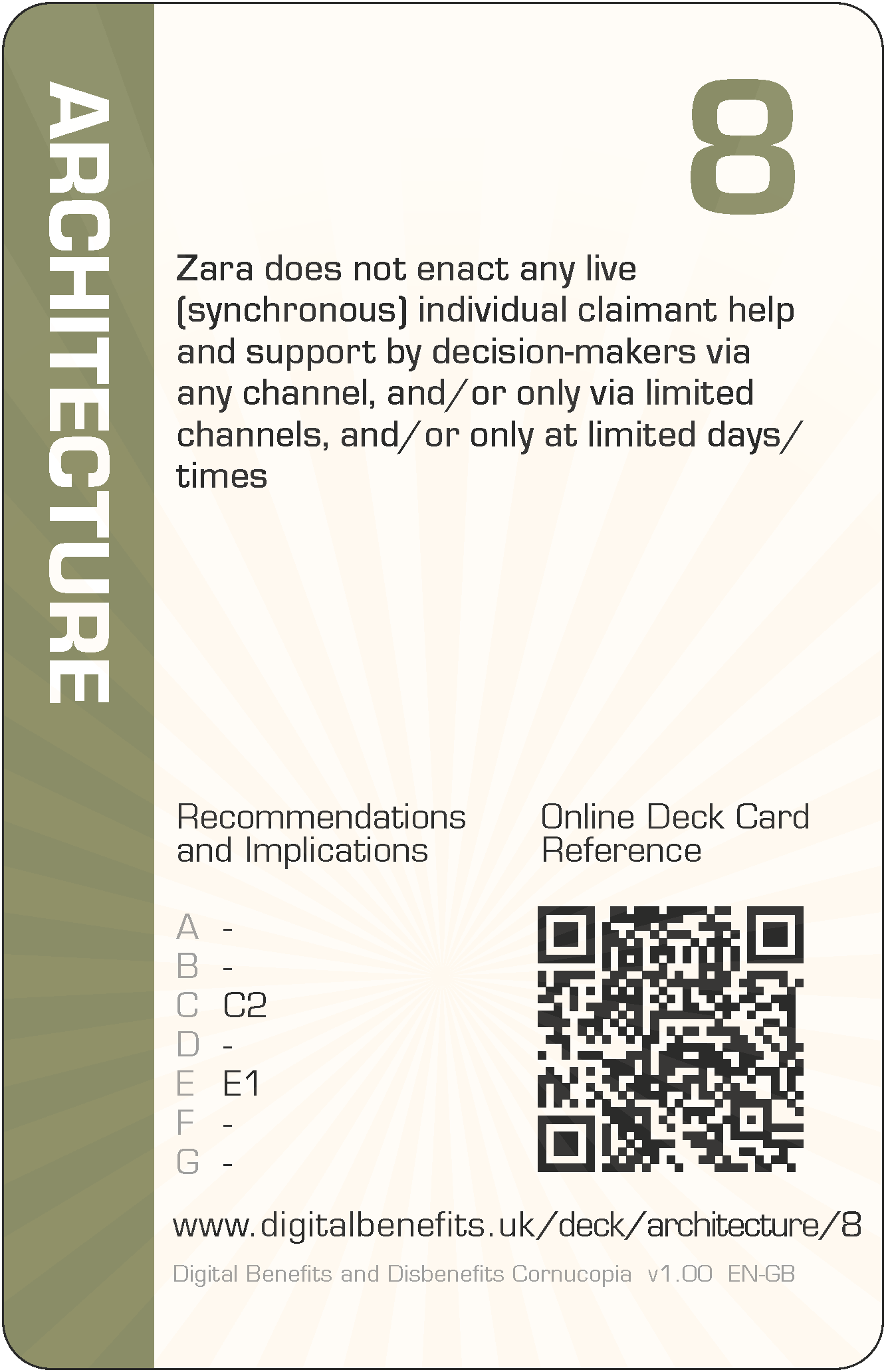Architecture 8 (AR-8) Card
DBD Cornucopia > Deck > Architecture > 8
Card Details - Eight of Architecture
Abbreviation
AR-8
Card's focus
The focus of this card is synchronous support by government officials
Threat to claimants
Zara does not enact any live (synchronous) individual claimant help and support by decision-makers via any channel, and/or only via limited channels, and/or only at limited days/times

Threat to claimants
Zara does not enact any live (synchronous) individual claimant help and support by decision-makers via any channel, and/or only via limited channels, and/or only at limited days/times.
Some examples of how this threat could lead to harms (negative effects on claimants)
The design recommendations and implications relevant to the card are listed below in the next section, but even those can be somewhat abstract and difficult to think about during practical day-to-day implementation. Therefore, some example harms are provided to complement the more formal research outputs. These examples are unique per card, and are only published on these web pages (i.e. in no other project outputs).
- Claimants cannot get instant help from government officials, and have to submit requests for help and then only later receive replies
- Asynchronous official support is subject to greater misunderstandings on both sides and adds delays to making a claim or undertaking activities required to maintain a claim
The examples are to help understand the threat on the card, not to suppress thinking and innovation. Incorporating these examples exactly, or closely matching ones, should be scored down when playing DBD Cornucopia as a game.
Applicable design recommendations and implications
These are reproduced here from Research Briefing N
Reduce claimants’ interaction burdens with digital welfare
- Provide greater flexibility and accommodations for claimants in the accuracy, precision, timeliness and permanence of the remaining information they provide
Design for people's lives which can be complex and where changing events and circumstances, often beyond their control, drive their need and eligibility for social protection payments. Allow adequate, rather than complete and precise, data that suffice for the state's needs. Increase flexibility of use by avoiding strict deadlines; limiting the use of actions that block progression; permitting correcting, updating and reversing information; and withdraw penalties for simple slips and lapses.
Design systems which support the division of labour with claimants' ecosystems
- Integrate accurate specific and contextual primary guidance about making claims within systems and promote secondary professional assistance
None
General Notes
Card values (i.e. '8' for this card) are for game play and are not correlated with the severity of harm. This is because threats cannot be ranked directly since they can affect individuals in different ways due to situations and circumstances, or affect fewer or more claimants, or the harms can arise in claimants' support networks and wider society.
The threat description uses a person's name as the "attacker" (i.e. 'Zara' for this card), which can be thought of someone involved with implementation. They could have any role which influence digitisation. So they could be a database administrator, or a copy writer, or a quality assurance specialist, etc, or all of these. Everyone could have some influence on the claimant threat described. The names were randomly selected from those currently most popular as given names for boys and girls (UK Office for National Statistics).
The example harms provided are drawn from the research data (which explored not only parts of existing services but also the effects of possible changes to those), from the author's own knowledge of web application development and testing, the author's own experience of helping citizens to claim Universal Credit (UC) and Personal Independence Payment (PIP), and from suggestions submitted by other people (make a suggestion). The threats and example harms do not necessarily exist in the current UC or PIP deployments or in ecosystems around those services, but they might well do.
All the cards in this Architecture suit are: 2 3 4 5 6 7 8 9 10 J Q K A
The other suits in the deck are: Scope, Agency, Trust, Porosity and Cornucopia (plus Jokers).
